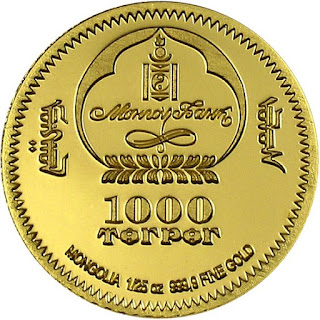Mongolia 1000 Tugrik Gold Coin 2006 Dancing Queen
Commemorative issue: Winter 2006 ice skating
Obverse: The obverse represents the Bank of Mongolia emblem and the inscriptions indicating the face value of the coin, the metal purity and weight.
Lettering: Mонгол Банк 1000 ТӨГРӨГ MONGOLIA 1/25 oz 999,9 FINE GOLD.
Translation: The Bank of Mongolia - Monggol Ulus (Mongolia) 1000 Tögrög.
Reverse: Dancing Queen, figure skating.
Lettering: DANCING QUEEN - WINTER 2006
Issuing country: Mongolia.
Coin Value: 1000 Togrog.
Material: Gold.
Quality: Proof.
Net Weight: 1/25 oz.
Diameter: 13.92 mm.
Max. Mintage: 25000.
Year: 2006.
Package Content: Coin in protective plastic capsule and coin certificate.
Design / Mint: Coin Invest Trust / B.H. Mayer.
A solid gold Mongolian coin that depicts an image of a woman ice-skating. The dancing queen gold coin is a great addition to any collection. The coin depicts an image of a woman dancing on ice. The Dancing Queen coin is one of 3 coins in the Dancing Queen series that were issued to celebrate the sport of figure skating. Other coins in this series include the other gold and silver version of the coin that include a valuable diamond set at the crown of the figure skater. The coin is 13.92 mm in diameter, 1/25 oz. in weight, and was issued in 2006 in Mongolia. It is of proof gold quality, and has a purity of .9999. The coin comes complete with a protective plastic capsule, and coin certificate.
Figure skating was the first Olympic sport that was included in the Olympics in 1908. The four Olympic disciplines in figure skating are men’s singles, ladies singles, pair skating, and ice dancing. In figure skating many athletes perform jumps, spins, and lifts in synchronization to music while being scored by judges. While people have been ice skating for centuries, figure skating in its current form originated in the mid-19th century. 'A Treatise on Skating' (1772) by Englishman Robert Jones, is the first known account of figure skating. Competitions were then held in the 'English style' of skating, which was stiff and formal, and bears little resemblance to modern figure skating. American skater Jackson Haines, considered the 'father of modern figure skating', and introduced a new style of skating in the mid-1860s. This style, which incorporated free and expressive techniques, became known as the 'international style.' Although popular in Europe, Haines' style of skating was not widely adopted in the United States until long after his death.

